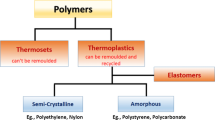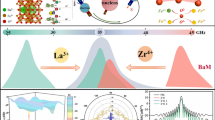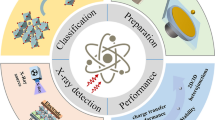Abstract
The objective of this study is to explore how the replacement of barium oxide (BaO) by bismuth oxide (Bi2O3) affects the optical, structural and gamma rays shield ability of borate glasses. To accomplish this, a series of borate-based glasses was fabricated according the chemical formula 60B2O3 + (40-x) BaO + xBi2O3, where 0 < x < 10 wt.%. X-ray diffraction confirmed that an amorphous phase was present at all fabricated glasses. Thermal analysis indicated that Bi2O3 could serve as a glass modifier for all values of x greater than zero. Furthermore, the optical absorption profile showed that the samples had a greater absorption rate as x increased within the 1–4 eV photon energy range, with only minor fluctuations beyond 4 eV. Monte Carlo simulation demonstrated that increasing the concentration of Bi2O3 led to an increased radiation-absorbing capacity, where the linear attenuation coefficient of the fabricated glasses enhanced by 26% from 74.48 to 94.17 cm−1 at gamma ray energy of 0.015 MeV. Simultaneously, the half value thickness for the fabricated glasses reduced from 3.99 to 3.73 cm, raising the Bi2O3 concentration between 0 and 10 wt.%, respectively. These results indicate that adding Bi2O3 to boron oxides can significantly improve shielding the ability of the material to against gamma rays, alter the glass samples, and potentially be cost-effective. This study could lead to faster synthesis processes for glass modifiers, with important implications for designing and producing materials to shield against harmful gamma rays in industrial and medical applications.







Similar content being viewed by others
Data availability
No data associated in the manuscript.
References
Abouhaswa, A.S., Sayyed, M.I., Mahmoud, K.A., Al-Hadeethi, Y.: Direct influence of mercury oxide on structural, optical and radiation shielding properties of a new borate glass system. Ceram. Int. 46, 17978–17986 (2020). https://doi.org/10.1016/j.ceramint.2020.04.112
Albarzan, B., Almuqrin, A.H., Koubisy, M.S., Wahab, E.A.A., Mahmoud, K.A., Shaaban, K.H.S., Sayyed, M.I.: Effect of Fe2O3 doping on structural, FTIR and radiation shielding characteristics of aluminium-lead-borate glasses. Progress Nucl. Energy 141, 103931 (2021a). https://doi.org/10.1016/j.pnucene.2021.103931
Albarzan, B., Hanfi, M.Y., Almuqrin, A.H., Sayyed, M.I., Alsafi, H.M., Mahmoud, K.A.: The influence of titanium dioxide on silicate-based glasses: an evaluation of the mechanical and radiation shielding properties. Materials. 14, 3414 (2021b). https://doi.org/10.3390/ma14123414
Al-Buriahi, M.S., Eke, C., Alomairy, S., Mutuwong, C., Sfina, N.: Micro-hardness and gamma-ray attenuation properties of lead iron phosphate glasses. J. Mater. Sci. Mater. Electron. 32, 13906–13916 (2021). https://doi.org/10.1007/s10854-021-05966-8
Al-Buriahi, M.S., Arslan, H., Tekin, H.O., Singh, V.P., Tonguc, B.T.: MoO3-TeO2 glass system for gamma ray shielding applications. Mater. Res. Express 7, 025202 (2020a). https://doi.org/10.1088/2053-1591/ab6db4
Al-Buriahi, M.S., Sriwunkum, C., Arslan, H., Tonguc, B.T., Bourham, M.A.: Investigation of barium borate glasses for radiation shielding applications. Appl. Phys. A 126, 68 (2020b). https://doi.org/10.1007/s00339-019-3254-9
Al-Hadeethi, Y., Sayyed, M.I., Rammah, Y.S.: Fabrication, optical, structural and gamma radiation shielding characterizations of GeO2-PbO-Al2O3–CaO glasses. Ceram. Int. 46, 2055–2062 (2020). https://doi.org/10.1016/j.ceramint.2019.09.185
Almuqrin, A. H., Hanfi, M., Mahmoud, K. G., Sayyed, M. I., Al-Ghamdi, H., Aloraini, D. A.: The role of La2O3 in enhancement the radiation shielding efficiency of the tellurite glasses: monte-carlo simulation and theoretical study. Materials 14(14), 3913 (2021). https://doi.org/10.3390/ma14143913
Aloraini, D.A., Sayyed, M.I., Almuqrin, A.H., Kumar, A., Mahmoud, K.A.: Bi2O3–PbO–CdO–B2O3 glasses: competent candidates for radiation shielding. Radiochim. Acta 110(11), 937–945 (2022). https://doi.org/10.1515/ract-2022-0046
Alsaif, N.A.M., Alotiby, M., Hanfi, M.Y., Mahmoud, K.A., Al-Yousef, H.A., Alotaibi, B.M., Sayyed, M.I., Al-Hadeethi, Y.: Comprehensive study of radiation shielding and mechanical features of Bi2O3-TeO2-B2O3-GeO2 glasses. J. Aust. Ceram. Soc. 57, 1267–1274 (2021). https://doi.org/10.1007/s41779-021-00623-z
Alzahrani, J.S., Sharma, A., Nazrin, S.N., Alrowaili, Z.A., Al-Buriahi, M.S.: Optical and radiation shielding effectiveness of a newly fabricated WO3 doped TeO2–B2O3 glass system. Radiat. Phys. Chem. 193, 109968 (2022). https://doi.org/10.1016/j.radphyschem.2022.109968
Ammar, H.R.: Mechanical behavior of nanostructured bulk aluminum at various temperatures. Mater. Res. Express 6, 1165f1 (2019). https://doi.org/10.1088/2053-1591/ab4dd2
Bao, Y., Lim, T.-T., Zhong, Z., Wang, R., Hu, X.: Acetic acid-assisted fabrication of hierarchical flower-like Bi2O3 for photocatalytic degradation of sulfamethoxazole and rhodamine B under solar irradiation. J. Colloid Interface Sci. 505, 489–499 (2017). https://doi.org/10.1016/j.jcis.2017.05.070
Boukhris, I., Kebaili, I., Al-Buriahi, M.S., Alalawi, A., Abouhaswa, A.S., Tonguc, B.: Photon and electron attenuation parameters of phosphate and borate bioactive glasses by using Geant4 simulations. Ceram. Int. 46, 24435–24442 (2020). https://doi.org/10.1016/j.ceramint.2020.06.226
Dong, M. G., Tishkevich, D. I., Hanfi, M. Y., Semenishchev, V. S., Sayyed, M. I., Zhou, S. Y., Grabchikov, S. S., Khandaker, M. U, Xue, X. X., Zhaludkevich, A. L., Razanau, I. U., Trukhanov, A. V.: WCu composites fabrication and experimental study of the shielding efficiency against ionizing radiation Radiation. Phys. Chem. 200, 110175 (2022). https://doi.org/10.1016/j.radphyschem.2022.110175
Guerrero, F., Govea-Alcaide, E., Mariño-Castellanos, P., Romaguera-Barcelay, Y., Anglada, J., Leyet, Y., Almeida, A., Vilarinho, R., Agostinho-Moreira, J.: Low-temperature dipolar polarization mechanisms in Ba0·9La0·1Fe12O19 ceramic hexaferrite. Ceram. Int. 46, 23941–23946 (2020). https://doi.org/10.1016/j.ceramint.2020.06.170
Hasegawa, T.: Optical properties of Bi2O3-TeO2-B 2O3 glasses. J. Non Cryst. Solids 357, 2857–2862 (2011). https://doi.org/10.1016/j.jnoncrysol.2011.03.021
Henych, J., Št’astný, M., Němečková, Z., Kormunda, M., Šanderová, Z., Žmudová, Z., Ryšánek, P., Stehlík, Š, Ederer, J., Liegertová, M., Trögl, J., Janoš, P.: Cerium-bismuth oxides/oxynitrates with low toxicity for the removal and degradation of organophosphates and bisphenols. ACS Appl. Nano Mater. 5, 17956–17968 (2022). https://doi.org/10.1021/acsanm.2c03926
Jiménez, J.A.: Spectroscopic and dilatometric analysis of low-melting bismuth borate glasses in the Bi2O3–BaO–Li2O–B2O3 quaternary. Mater. Chem. Phys. 255, 123635 (2020). https://doi.org/10.1016/j.matchemphys.2020.123635
Libeesh, N.K., Naseer, K.A., Mahmoud, K.A., Sayyed, M.I., Arivazhagan, S., Alqahtani, M.S., Yousef, E.S., Khandaker, M.U.: Applicability of the multispectral remote sensing on determining the natural rock complexes distribution and their evaluability on the radiation protection applications. Radiat. Phys. Chem. 193, 110004 (2022). https://doi.org/10.1016/j.radphyschem.2022.110004
Liu, J., Xu, X., Zheng, T., Guo, Y., Lv, J.: Effect of Bi2O3 content on the structure and properties of Bi2O3-B2O3-BaO-ZnO glass. J. Non Cryst. Solids 575, 121211 (2022). https://doi.org/10.1016/j.jnoncrysol.2021.121211
Mahmoud, K.A., Tashlykov, O.L., Almuqrin, A.H., Sayyed, M.I., Vlasova, S.G.: Assessment of mechanical and radiation shielding capacity for a ternary CdO–BaO–B2O3 glass system: a comprehensive experimental, Monte Carlo simulation, and theoretical studies. Prog. Nucl. Energy 146, 104169 (2022). https://doi.org/10.1016/j.pnucene.2022.104169
Mahmoud, K.A., Lacomme, E., Sayyed, M.I., Özpolat, F., Tashlykov, O.L.: Investigation of the gamma ray shielding properties for polyvinyl chloride reinforced with chalcocite and hematite minerals. Heliyon 6, 0–7 (2020). https://doi.org/10.1016/j.heliyon.2020.e03560
Marltan, W., Venkateswara Rao, P., Tekin, H.O., Sayyed, M.I., Klement, R., Galusek, D., Lakshminarayana, G., Syam Prasad, P., Veeraiah, N.: Analysis of red mud doped Bi2O3-B2O3-BaO glasses for application as glass solder in radiation shield repair using MCNPX simulation. Ceram. Int. 45, 7619–7626 (2019). https://doi.org/10.1016/j.ceramint.2019.01.058
Sayyed, M.I., Tekin, H.O., Agar, O.: Gamma photon and neutron attenuation properties of MgO–BaO–B2O3–TeO2–Cr2O3 glasses: the role of TeO2. Radiat. Phys. Chem. 163, 58–66 (2019). https://doi.org/10.1016/j.radphyschem.2019.05.012
Sayyed, M.I., Mahmoud, K.A., Tashlykov, O.L., Khandaker, M.U., Faruque, M.R.I.: Enhancement of the shielding capability of soda-lime glasses with Sb2o3 dopant: a potential material for radiation safety in nuclear installations. Appl. Sci. 11, 326 (2020). https://doi.org/10.3390/app11010326
Sayyed, M.I., Hanfi, M.Y., Mahmoud, K.A., Abdelaziem, A.: Theoretical investigation of the radiation-protection properties of the CBS glass family. Optik (stuttg) 258, 168851 (2022). https://doi.org/10.1016/j.ijleo.2022.168851
Schott AG: Radiation shielding glasses. Hattenbergstrasse 10 55122 Mainz Germany (2013)
Singh, S.P., Karmakar, B.: Synthesis and characterization of low softening point high Bi2O3 glasses in the K2O–B2O3–Bi2O3 system. Mater Charact 62, 626–634 (2011). https://doi.org/10.1016/j.matchar.2011.04.007
Thakur, S., Thakur, V., Kaur, A., Singh, L.: Structural, optical and thermal properties of nickel doped bismuth borate glasses. J. Non Cryst. Solids 512, 60–71 (2019). https://doi.org/10.1016/j.jnoncrysol.2019.02.012
Thakur, S., Thakur, V., Kaur, A., Singh, L.: Synthesis and the study of structural, thermal and optical properties of (100–x)Bi2O3-x(BaO-TiO2) glass system. Optik (stuttg) 223, 165646 (2020). https://doi.org/10.1016/j.ijleo.2020.165646
Tijani, S.A., Kamal, S.M., Al-Hadeethi, Y., Arib, M., Hussein, M.A., Wageh, S., Dim, L.A.: Radiation shielding properties of transparent erbium zinc tellurite glass system determined at medical diagnostic energies. J. Alloys Compd. 741, 293–299 (2018). https://doi.org/10.1016/j.jallcom.2018.01.109
Wang, S.F., Lai, B.C., Hsu, Y.F., Lu, C.A.: Dielectric properties of CaO–B2O3–SiO2 glass-ceramic systems in the millimeter-wave frequency range of 20–60 GHz. Ceram. Int. (2021). https://doi.org/10.1016/j.ceramint.2021.04.275
X-5 Monte Carlo Team: MCNP—a general Monte Carlo N-particle transport code, Version 5. La-Ur-03–1987. II, (2003)
Yang, W., Sun, Q., Lei, Q., Zhu, W., Li, Y., Wei, J., Li, M.: Formation of a highly conductive thick film by low-temperature sintering of silver paste containing a Bi2O3-B2O3-ZnO glass frit. J. Mater. Process. Technol. 267, 61–67 (2019). https://doi.org/10.1016/j.jmatprotec.2018.09.029
Yıldız Yorgun, N.: Gamma-ray shielding parameters of Li2 B4 O7 glasses: undoped and doped with magnetite, siderite and Zinc-Borate minerals cases. Radiochim. Acta 107, 755–765 (2019). https://doi.org/10.1515/ract-2019-0014
Zhao, G., Tian, Y., Fan, H., Zhang, J., Hu, L.: Properties and structures of Bi2O3-B2O3-TeO2 glass. J. Mater. Sci. Technol. 29, 209–214 (2013). https://doi.org/10.1016/j.jmst.2012.11.003
Zhou, Y., Yang, Y., Huang, F., Ren, J., Yuan, S., Chen, G.: Characterization of new tellurite glasses and crystalline phases in the TeO2-PbO-Bi2O3-B2O3 system. J. Non Cryst. Solids 386, 90–94 (2014). https://doi.org/10.1016/j.jnoncrysol.2013.11.037
Zhu, Y., Xue, J., Xu, T., He, G., Chen, H.: Enhanced photocatalytic activity of magnetic core–shell Fe3O4@Bi2O3–RGO heterojunctions for quinolone antibiotics degradation under visible light. J. Mater. Sci. Mater. Electron. 28, 8519–8528 (2017). https://doi.org/10.1007/s10854-017-6574-6
Funding
No funding.
Author information
Authors and Affiliations
Contributions
AR and IK were responsible for synthesizing the glass samples and collecting XRD, DTA, and UV–VIS-NIR data. AA wrote the manuscript with the assistance of the other authors. MYH and KAM conducted the MC simulation and analysed the simulated results. The authors contributed to the data analysis, discussion, and interpretation of the findings.
Corresponding authors
Ethics declarations
Conflict of interest
The authors declare no competing interests.
Additional information
Publisher's Note
Springer Nature remains neutral with regard to jurisdictional claims in published maps and institutional affiliations.
Rights and permissions
Springer Nature or its licensor (e.g. a society or other partner) holds exclusive rights to this article under a publishing agreement with the author(s) or other rightsholder(s); author self-archiving of the accepted manuscript version of this article is solely governed by the terms of such publishing agreement and applicable law.
About this article
Cite this article
Ratep, A., Abdelaziem, A., Hanfi, M.Y. et al. Enhancing gamma-ray shielding with bismuth oxide-infused boron oxides. Opt Quant Electron 56, 143 (2024). https://doi.org/10.1007/s11082-023-05788-4
Received:
Accepted:
Published:
DOI: https://doi.org/10.1007/s11082-023-05788-4




